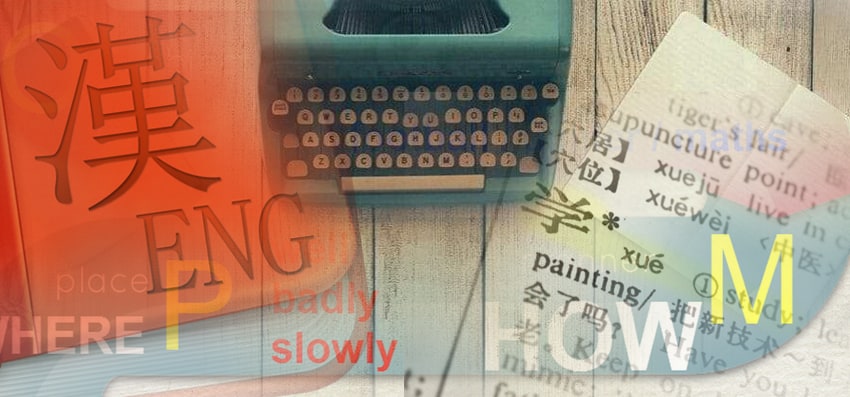Throughout the articles in this series, we have looked at the basics of English and Chinese, specifically the characteristics of each language in both writing and speech, as well as how sentences are formed in these two languages. Follow us in this bonus article as we delve deeper into our comparison of the two most popular languages in the world when we take a look at the different types of words (or word classes) that are used in both English and Chinese.
- Word Classes
Simply put, a word class refers to a category of words that have a similar form or function, such as nouns, verbs, adjectives, adverbs, etc. Although English consists of roughly 10 word classes that overlap with the 11 word classes in Chinese, both languages possess their own unique word classes as shown below:
| English | Chinese | |||
| Word Class | Examples | 词类 | 例子 | |
| 1. | Noun | Sun, moon, dog, car | 名词 | 太阳,月亮,狗,车 |
| 2. | Pronoun | He, she, I, you | 代词 | 你,我,他/她 |
| 3. | Verb | Eat, moves, lives, sleeps | 动词 | 吃,喝,睡觉,生活 |
| 4. | Adjective | Beautiful, hot, cold, sunny | 形容词 | 美丽,热,冷,晴朗 |
| 5. | Adverb | Beautifully, happily, quickly | 副词 | 经常,一直,忽然 |
| 6. | Preposition | On, below, in, out | 介词 | 在…上/下,从…开始 |
| 7. | Numeral | First, second, third | 数词 | 一,二,三 |
| 8. | Conjunction | And, but, or, although | 连词 | 但是,因为 |
| 9. | Interjection | Oh, ouch, aha | 叹词 | 啊,嘛,哦 |
| 10. | Article | A, an, the, | 量词 (Classifier) |
本,辆,瓶,杯,张,支 |
| 11. | 助词 (Particle) | 着,了,过,的 | ||
Compared to the Chinese language, English has a word class that is unique: articles. They are a class of words that are used to indicate whether a noun is specific or general, e.g. “It is a car.” v. “It is the car.”
Similarly, while Chinese does not make use of articles, it has two unique word classes that are not found in English: Classifiers (量词) and particles (助词). Unlike English, classifiers are inserted between a number and a noun when describing a quantity in Chinese:
| A book, 2 cars, 3 houses | 一本书,两辆车,三栋房子 |
Particles are words that serve a grammatical function but do not fit into the main speech. While English also has particles (e.g. to fly), these words are usually words from existing word classes. In contrast, Chinese particles are words that are used specifically to express how actions are related to the flow of time, or how different components of a sentence relate to each other:
| He is eating lunch. | 他正吃着午饭。 |
| He has eaten lunch. | 他吃了午饭。 |
As shown above, the verb “to eat” in English has been conjugated to “is eating” and “has eaten” to indicate when the action is taking place. However, as Chinese words do not change their form, the Chinese word for “eat”, “吃 (chī)”, remains unchanged. Instead, particles such as “着(zhè)” and “了(lè)” are used to show tense.
Apart from the word classes that are unique to each language, perhaps the biggest difference between the two languages in terms of word classes is in the way adverbs—words that describe actions—are used.
| 1. He left the room quickly. | 他离开房间时去得匆匆。 |
| 2. He quickly left the room. | 他匆匆地离开房间。 |
Word order is more flexible in English. Hence, the adverb “quickly” can be placed before or after the verb (action word) without affecting the nature of the word itself. However, as word order is stricter in Chinese, adverbs generally have to be placed before the verb. In example 2, the corresponding adverb for “quickly”, “匆匆” (cōngcōng), is used correctly as an adverb. When placed after the verb, the word becomes an adjective instead, illustrating the strict position that adverbs have in general in Chinese.
Furthermore, English adverbs far outnumber Chinese adverbs. For every English adjective, a corresponding adverb can be formed by changing its form, e.g. happyàhappily, beautifulàbeautifully, etc. In contrast, as Chinese words are unable to change their form, the number of adverbs available is limited to words that describe frequency, range, etc.
Despite the seeming similarities between English and Chinese, there are still significant differences in terms of the word classes each languages possesses which has to be taken into account when translating between the two.
Find out more about how Lingua Technologies can better support your translation requirements not just in English and Chinese, but also in a wide range of languages ranging from Asian, European to Middle Eastern and Nordic languages. Visit https://www.translationsingapore.com/ or send your enquiries to inquiry@translationsingapore.com.

